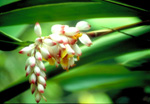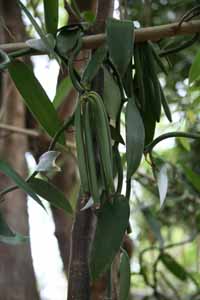Articles
10 July 2007
Zanzibar, the island of spices
Do you know that nutmeg trees are huge and the under-forest is dark or cinnamon leaves are good for chewing and pepper is hot, green and fresh-tasting before it is dried and ground to become black pepper?
Spice farms on Zanzibar are like gardens, with trees, shrubs and grasses all grown together, and there, some of the friendly guides will show us some of the fragrant secrets hidden beneath the shade of mango and jackfruit trees.
At one time in its history, this archipelago of white sandy beaches produced over 90% of the world's clove supply. Persian and Arab traders built settlements along the coast of Tanzania and on the Zanzibar islands, integrated themselves into the African societies and left a wonderful legacy with their food. They brought coconut palms, mango trees, citrus fruits, rice and all the spices in an attempt to start production and thus eliminate the Far Eastern monopoly. Although most of the new crops adapted well to Zanzibar's tropical climate, the other spices never flourished in quite the same way as the clove industry, but instead remained a low-key affair, supplying ingredients for local consumption and for limited trade in the Indian Ocean.
The capital of this semiautonomous state of the United Republic of Tanzania, Stone Town, has narrow winding streets, vivid markets and colourful bazaars which fascinate every soul. There are still many buildings standing from the days of the great sultans who ruled this Island and the merge of cultures between Africans, Arabs and Indians all abound and are explicit in Zanzibar.
A drive through the countryside provides a chance to visit some one of the circular huts were the delightful hospitality of the women and the aromas of whole sweet potatoes baking will impress anybody.
When the wind blows in the right direction, the fragrance of spice is deliciously strong, and you know you are in Zanzibar.
So, it is time to go shopping, Zanzibar Island's markets are packed with fresh fruits and vegetables (Bananas and plantains, cassava, addoes (a potato-like vegetable), hot red peppers, and all kinds of green vegetables are in plentiful supply in their stalls), exotic spices and fish still dripping with sea water. Of course fish and fresh seafood gleaned from the warm waters of the Indian Ocean surrounding these islands.
Zanzibar menu
Pilau rice is one of the island's most common and delicious dishes cooked with coconut, nuts, and spices, is of Arab origin. This spicy rice comes in a giant copper hour-glass shaped pilau pan. The best way to enjoy this dish is to sit in a circle around a large platter piled high with pilau, remembering, always, to use the right hand, and eat communally from the pot.
Usually it comes together with a salad of slice onions placed in a shallow dish and marinated, for at least one hour, in lime juice, sliced chilies and sugar, and also with thinly sliced tomato and cucumber and topped with chopped, fresh coriander.
Ugali, the stiff porridge made from maize flour. Especially nice with Mchicha, one of the most popular spinaches that has small oval leaves and thin stems.
Another favorite dish is sorpotel, a stew of beef tongue, heart, liver and pork. It has a spicy complex flavor that is unique from any curry or masala.
Chips-my-eye, (Swahili = Chips mayai) is a traditional dish too: It is a chip omelette. Chips are placed into a shallow frying pan and as they sizzle away two beaten eggs are poured over the top. This is then cooked into a solid omelette, stuffed with chips. An ideal lunchtime snack usually provided with a bottle of chilli ketchup. As an extra, a few slices of fresh tomato are often placed on the side of the plate.
Enjoy!
Dra. Laura Gosalbo
July 2007


Cardamom flowe Pepper

Clove

...and if we need a natural colouring additive...

Vainille
> BackSpice farms on Zanzibar are like gardens, with trees, shrubs and grasses all grown together, and there, some of the friendly guides will show us some of the fragrant secrets hidden beneath the shade of mango and jackfruit trees.
At one time in its history, this archipelago of white sandy beaches produced over 90% of the world's clove supply. Persian and Arab traders built settlements along the coast of Tanzania and on the Zanzibar islands, integrated themselves into the African societies and left a wonderful legacy with their food. They brought coconut palms, mango trees, citrus fruits, rice and all the spices in an attempt to start production and thus eliminate the Far Eastern monopoly. Although most of the new crops adapted well to Zanzibar's tropical climate, the other spices never flourished in quite the same way as the clove industry, but instead remained a low-key affair, supplying ingredients for local consumption and for limited trade in the Indian Ocean.
The capital of this semiautonomous state of the United Republic of Tanzania, Stone Town, has narrow winding streets, vivid markets and colourful bazaars which fascinate every soul. There are still many buildings standing from the days of the great sultans who ruled this Island and the merge of cultures between Africans, Arabs and Indians all abound and are explicit in Zanzibar.
A drive through the countryside provides a chance to visit some one of the circular huts were the delightful hospitality of the women and the aromas of whole sweet potatoes baking will impress anybody.
When the wind blows in the right direction, the fragrance of spice is deliciously strong, and you know you are in Zanzibar.
So, it is time to go shopping, Zanzibar Island's markets are packed with fresh fruits and vegetables (Bananas and plantains, cassava, addoes (a potato-like vegetable), hot red peppers, and all kinds of green vegetables are in plentiful supply in their stalls), exotic spices and fish still dripping with sea water. Of course fish and fresh seafood gleaned from the warm waters of the Indian Ocean surrounding these islands.
Zanzibar menu
Pilau rice is one of the island's most common and delicious dishes cooked with coconut, nuts, and spices, is of Arab origin. This spicy rice comes in a giant copper hour-glass shaped pilau pan. The best way to enjoy this dish is to sit in a circle around a large platter piled high with pilau, remembering, always, to use the right hand, and eat communally from the pot.
Usually it comes together with a salad of slice onions placed in a shallow dish and marinated, for at least one hour, in lime juice, sliced chilies and sugar, and also with thinly sliced tomato and cucumber and topped with chopped, fresh coriander.
Ugali, the stiff porridge made from maize flour. Especially nice with Mchicha, one of the most popular spinaches that has small oval leaves and thin stems.
Another favorite dish is sorpotel, a stew of beef tongue, heart, liver and pork. It has a spicy complex flavor that is unique from any curry or masala.
Chips-my-eye, (Swahili = Chips mayai) is a traditional dish too: It is a chip omelette. Chips are placed into a shallow frying pan and as they sizzle away two beaten eggs are poured over the top. This is then cooked into a solid omelette, stuffed with chips. An ideal lunchtime snack usually provided with a bottle of chilli ketchup. As an extra, a few slices of fresh tomato are often placed on the side of the plate.
Enjoy!
Dra. Laura Gosalbo
July 2007


Cardamom flowe Pepper

Clove

...and if we need a natural colouring additive...

Vainille





